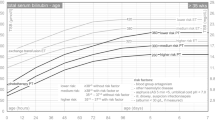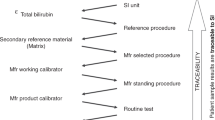Abstract
Objective:
The purpose of this study was to validate primary health-care workers' and physicians' visual assessment of neonatal hyperbilirubinemia in Karachi, Pakistan.
Study Design:
We compared primary health-care workers' and physicians' clinical identification of jaundice in infants <60 days old.
Result:
Primary health-care workers identified 1- to 20-day-old neonates with hyperbilirubinemia ⩾15 mg per 100 ml (260 μmol l−1) with 83.3% sensitivity and 50.5% specificity; neonates aged 1 to 6 days were identified with 76.2% sensitivity and 60.7% specificity. Physicians identified neonates aged 1 to 20 days with hyperbilirubimemia ⩾15 mg per 100 ml (260 μmol l−1) with 51.4% sensitivity and 90.7% specificity, and neonates aged 1 to 6 days with 50% sensitivity and 88.5 % specificity. The primary health-care workers' and physicians' assessments showed fair interobserver agreement (κ statistic 0.29).
Conclusion:
Primary health-care workers identified hyperbilirubinemic neonates with adequate sensitivity. With proper training and supervision, their assessment could improve the referral of hyperbilirubinemic neonates in low-resource settings in the developing world.
This is a preview of subscription content, access via your institution
Access options
Subscribe to this journal
Receive 12 print issues and online access
$259.00 per year
only $21.58 per issue
Buy this article
- Purchase on Springer Link
- Instant access to full article PDF
Prices may be subject to local taxes which are calculated during checkout

Similar content being viewed by others
References
Narayanan I, Banwalikar J, Mehta R, Ghorpade M, Peesay MR, Nanda S et al. A simple method of evaluation of jaundice in the newborn. Ann Trop Paediatr 1990; 10: 31–34.
Connolly AM, Volpe JJ . Clinical features of bilirubin encephalopathy. Clin Perinatol 1990; 17: 371–379.
Goswami V, Kumar DA, Singh V, Chandra J . Evaluation of simple clinical signs of illness in young infants (0–2 months) and its correlation with WHO IMCI algorithm (7 days to 2 months). Indian Pediatr 2006; 43: 1042–1049.
Kramer LI . Advancement of dermal icterus in the jaundiced newborn. Am J Dis Child 1969; 118: 454–458.
Ebbesen F . Relationship between the cepahlo-pedal progress of clinical icterus and the serum bilirubin concentration in newborn infants without blood type sensitization. Acta Obstet Gynecol Scand 1975; 54: 329–332.
Riskin A, Kuglman A, Abend-Weinger M, Green M, Hemo M, Bader D . In the eye of the beholder: how accurate is clinical estimation of jaundice in newborns? Acta Paediatr 2003; 92: 574–576.
Madlon-Kay DJ . Recognition of the presence and severity of newborn jaundice by parents, nurses, physicians, and icterometer. Pediatrics 1997; 100: E3.
Madlon-Kay DJ . Home health nurse clinical assessment of neonatal jaundice: comparison of 3 methods. Arch Pediatr Adolesc Med 2001; 155: 583–586.
Szabo P, Wolf M, Ulrich Bucher H, FauchŸre JC, Haenesse D, Arlettaz R . Detection of hyperbilirubinaemia in jaundiced full-term neonates by eye or by bilirubinometer. Eur J Pediatr 2004; 163: 722–727.
Szabo P, Wolf M, Ulrich Bucher HU, Haenesse D, FauchŸre JC, Arlettaz R . Assessment of jaundice in preterm neontates: comparison between clinical assessment, two transcutaneous bilirubinometers and serum bilirubin values. Acta Paediatr 2004; 93: 1491–1495.
Knudsen A, Brodersen R . Skin colour and bilirubinemia in neonates. Arch Dis Child 1989; 64: 605–609.
Moyer VA, Ahn C, Sneed S . Accuracy of clinical judgement in neonatal jaundice. Arch Pediatr Adolesc Med 2000; 154: 391–394.
Young Infants Clinical Signs Study Group. Clinical signs predicting severe illness in young infants: a multicentre study. Lancet 2008; 12: 135–142.
Subcommittee on Hyperbilirubinemia. Management of hyperbilirbubinemia in the newborn infant 35 or more weeks of gestation. Pediatrics 2004; 114: 297–316.
Kaplan M, Hammerman C . Understanding and preventing severe neonatal hyperbilirubinemia: is bilirubin neurotoxicity really a concern in the developed world?. Clin Perinatol 2004; 31: 555–575, x.
Landis JR, Koch GG . The measurement of observer agreement for categorical data. Biometrics 1977; 33: 159–174.
StataCorp. Stata Statistical Software: Release 10.0. Stata Corporation, College Station: TX, 2005.
Acknowledgements
We thank the study participants from the three study communities for their willingness to participate in the study; the lady health visitors (Razia Awaldad, Nasira A Jabbar, Mussarat Omer); Save the Children-US (through a grant from the Bill & Melinda Gates Foundation) who provided funding for the data collection and analysis; Martin Weber and Rajiv Bahl from the Child and Adolescent Health and Development Department at the World Health Organization, David Hamer at Boston University and John Carlin at the University of Melbourne, for their technical help in study design, and Dr Marie Deiner-West and Dr John McGready of the Biostatistics Department, and Dr Rosa Crum of the Epidemiology Department at the Johns Hopkins Bloomberg School of Public Health for their professional advice in the data analysis and reporting of results.
Author information
Authors and Affiliations
Corresponding author
Ethics declarations
Competing interests
The investigators have no competing interests and received no financial gain from the study results.
Additional information
Supplementary Information accompanies the paper on the Journal of Perinatology website
Rights and permissions
About this article
Cite this article
Hatzenbuehler, L., Zaidi, A., Sundar, S. et al. Validity of neonatal jaundice evaluation by primary health-care workers and physicians in Karachi, Pakistan. J Perinatol 30, 616–621 (2010). https://doi.org/10.1038/jp.2010.13
Received:
Revised:
Accepted:
Published:
Issue Date:
DOI: https://doi.org/10.1038/jp.2010.13
Keywords
This article is cited by
-
Acceptability and operational feasibility of community health worker-led home phototherapy treatment for neonatal hyperbilirubinemia in rural Bangladesh
BMC Pediatrics (2024)
-
Modified Kramer’s versus Kramer’s Method for Clinical Assessment of Jaundice in Term and Near-Term Neonates
Indian Journal of Pediatrics (2024)
-
Feasibility and acceptability of home-based neonatal hyperbilirubinemia screening by community health workers using transcutaneous bilimeters in Bangladesh
BMC Pediatrics (2023)
-
Evaluation of community health worker's performance at home-based newborn assessment supported by mHealth in rural Bangladesh
BMC Pediatrics (2022)
-
Reliability of visual assessment of neonatal jaundice among neonates of black descent: a cross-sectional study from Tanzania
BMC Pediatrics (2021)



